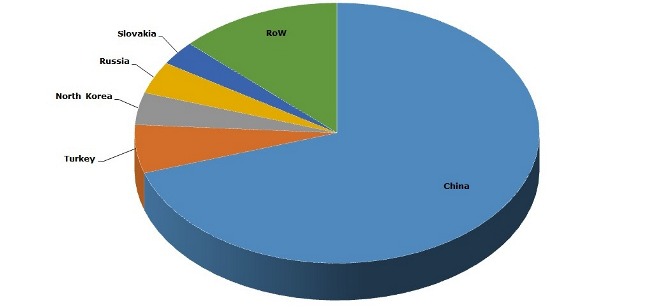The term magnesite is used to refer to magnesium carbonate (MgCO3) or sometimes commercially to magnesium products, like magnesium oxide (magnesia, MgO). The main application sphere of mined magnesite is the production of magnesium oxide, which has two most common grades: dead burned magnesia (DBM) and fused magnesia (FM). The latter features more superior qualities than DBM. Fused magnesia is mostly applied in refractory and electrical insulating markets. The principal end-use sector for refractory material is iron and steel industry that accounts for 70% of product demand in volume terms. Other applications of magnesium and its compounds include agriculture, chemical industry, construction, environmental area, pharmaceuticals, to name only a few. The world magnesite mine production was estimated 6.97 million tonnes in 2014 (excluding the USA) with China accounting for over 70% of total global output.
Top magnesite-producing countries, 2014

Dead-burned magnesia and fused magnesia was also produced in Australia, Brazil, Israel, Japan, the Republic of Korea, Mexico, North Korea, Norway, Russia, Turkey, the USA, etc. The diversity of magnesia production sources prevents market monopolization, though might act as a factor reinforcing market volatility. Refractory-grade MgO prices have been traditionally quite volatile, while prices for chemical magnesia grades have been showing larger stability. The global supply of magnesia and magnesium compounds is expected to be sufficient to meet global demand. The total magnesia market is expected to grow annually by 3.2% to 2018. Refractory materials will remain the major application sphere for global magnesite demand.
More information on the magnesium market can be found in the in-demand report “Magnesium and Compounds: 2016 World Market Review and Forecast”.
